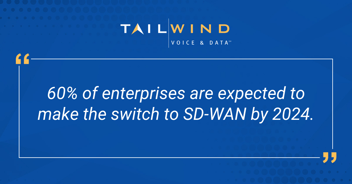The COVID-19 pandemic has compelled enterprises to reinvent the way they operate. Businesses across all sectors have had to adopt digital technologies to survive the turbulent waters of the last year and a half. The shift is expected to continue even after the pandemic is over. According to the IDC, investments in digital transformation are expected to cross $6.8 billion between 2020 and 2023.1
As businesses digitally transform and adopt cloud technologies, they find they need to reinforce their network infrastructure to support new applications and solutions. Often, this means switching from a traditional multi-protocol label switching (MPLS) network to software-defined wide area networking (SD-WAN).
SD-WAN also supports the move to a remote workforce – a business reality that isn’t going anywhere anytime soon. The remote workforce is expected to grow2 from 16.4% (before 2020) to 34.4% in 2021. Even after the pandemic is over, businesses are likely to continue implementing remote work policies. By 2025, 70% of an organization’s workforce3 is expected to work remotely for at least five days a month. Traditional MPLS doesn’t offer the network capabilities to support reliable and uninterrupted access to employees at different locations.
SD-WAN offers a scalable and affordable network solution for organizations with a dispersed workforce, but the transition from MPLS to SD-WAN requires a well-defined strategy. In the following sections, we’ll discuss a few useful tips to help you successfully upgrade your existing network to SD-WAN.
1. Conduct a Network Audit
The first step of migrating to SD-WAN from MPLS is to get a thorough overview of your existing network infrastructure.
Find out the type of internet connectivity that’s been deployed at different locations. Also, analyze network usage patterns of different employees and teams. Identify various types of applications that are used on each network, too.
2. Review MPLS Contracts
Most MPLS carriers insert suitable clauses in their contracts to prevent you from abruptly terminating their services.
Review any such clauses in your existing MPLS contracts before rolling out a company-wide SD-WAN deployment. Talk to your vendor to explore possibilities of switching to a month-by-month plan until the transition is successfully completed.
3. Choose the Right SD-WAN Solution
First-generation, hardware-based SD-WAN lacked the much-needed support for cloud-based applications. It’s wiser to select software-based SD-WAN solutions that shift main functionalities to the cloud. Working with an expert technology guide will enable you to evaluate which SD-WAN solution is best fit for your business.
4. Find a Reliable IT Partner
Switching from MPLS to SD-WAN is a complicated process that requires experienced and skilled IT professionals.
In addition to deploying a suitable SD-WAN solution, you also have to monitor and maintain the network. Otherwise, it could interrupt business operations and affect employee productivity.
That’s why it’s smart to outsource the transition to a reliable and trustworthy IT partner, such as TailWind. It’ll save you the trouble of recruiting and training in-house personnel to oversee the migration and manage your network.
Instead, you can leverage expert guidance and insight from resourceful IT professionals who have years of experience in deploying similar projects.TailWind will help you kickstart the digital transformation of your business. Get in touch today to explore our broad spectrum of solutions.


